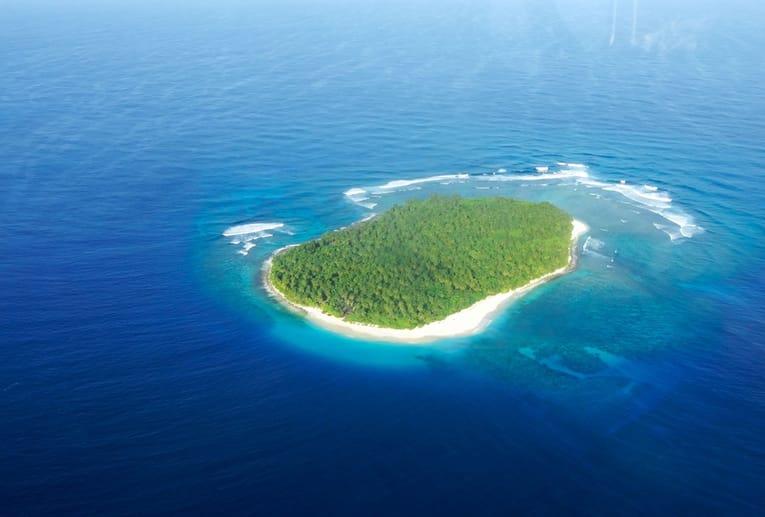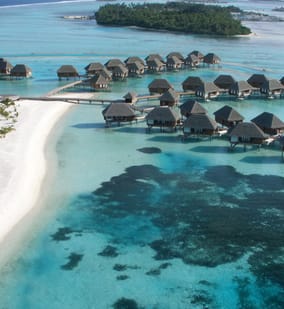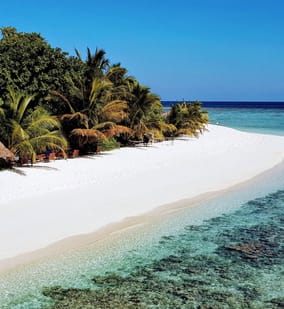Protecting Paradise: How Low-Lying Maldives Prepares for Rising Seas

The Maldives has a long and proud history, from its formation by prehistoric volcanoes millions of years ago to the vibrant communities and luxury resorts found there today.
More than 1.7 million people visited the Maldives in 2019, and due to COVID-19 global travel restrictions, 2020 recorded 555,399 tourist arrivals. 2021 will be a hopeful year for the Maldives as tourism is booming again, all visitors looking for its famed white sand islands, shallow turquoise lagoons and real-life castaway experience.
But as the effects of global warming increase, those dreaming of their own paradise escape should think about visiting soon – before it’s too late.
The island nation’s unique geography – hundreds of pristine coral islands dotted along a double chain in the Indian Ocean, is what makes it a paradise destination, but it also leaves it susceptible to environmental change.
Maldives islands are among the most low-lying in the world, sitting just a few feet above sea level, and as climate change causes sea levels to rise, there is a real risk that islands could be lost completely. Scientists believe that if global warming continues, the country could be swallowed up by the ocean within decades.
So how did so many spectacular specks of land come to be shaped in such a unique yet vulnerable formation?
How The Country Was Formed…
To understand this, we look back millions of years to when the earth’s shifting tectonics caused huge land masses to break into the continents as we know them today.
Back then, where the Maldives now stands was a volcanic belt. As these volcanoes went extinct and sank into the ocean, corals began to grow around their peak, becoming a fringed reef enclosing a lagoon. As these corals eroded, the material gathered on the shallow reefs, becoming sand banks and eventually islands over millions of years.
The result was hundreds of islands sprawling some 90,000 km2 of ocean, sitting atop a 960km long submarine ridge that rises from the ocean floor. The Maldives’ geography was formed.
Preparing for the Effects of Climate Change...
This unique geological history has given the country an uncertain future. Climate change threatens the nation’s very existence, so there is a real urgency in preserving its natural environment and preparing for what lies ahead.
The government is enacting a number of plans to protect the islands and its citizens from rising seas. These include preserving groundwater and increasing rainwater harvesting, fighting coastal erosion, as well as increasing the elevation of critical infrastructure – the vast majority of which is located by the coast.
Citizens on some of the most outlying and vulnerable islands have already been relocated to islands with better natural protections.
The construction of island sea walls, such as the one surrounding the capital Male, is possible, but all this takes funds. The Government has set out its commitment to supporting and investing in tourism as the country’s main means of generating funds for climate change defences and seeking international financial help.
Biodiversity is also top of the agenda, and the Government has designated various nature reserves to protect wetlands and mangroves and biospheres to protect coral reefs – all important habitats that help protect against flooding.
Climate Action…
Equally as important as preparing defences for the future is education about what is happening right now and taking steps to combat climate change at its source.
The Maldives has taken action on plastic waste, passing an ambitious law to ban single-use plastics nationwide by 2025 and banning the import of plastic bags. Single-use plastics are already banned in all Maldivian schools.
There are no widespread recycling programmes in the country, but over the past couple of years, state-run Waste Management Corporation (WAMCO) has collaborated with Parley for the Oceans – an environmental organisation dedicated to reducing ocean plastic pollution – to establish an innovative plastic recycling laboratory in Malé City.
There is a range of volunteer and community education programmes, from beach clean-ups to sea turtle preservation, to raise environmental awareness among visitors and citizens. School children and fishermen have been mobilised to clear plastic waste from the waters and beaches, and tourists can get involved in a range of activities to protect marine life and coral reefs.
The Maldives' famous luxury resorts have also been going green – with a sharp rise in eco-tourism and a focus on sustainability.
A particularly innovative and exciting project is the Maldives Matter Project, from the Resilient Island group, which is working to develop the world’s first self-sufficient greenhouse project in a tropical lowland climate. Around 95% of the food in the country is imported, and the Maldives Matter Project aims to cut carbon emissions and cultivate local food production.
Visit Before It’s Too Late!
If the Maldives has long been your dream destination, be sure to visit sooner rather than later. While we may not know what the future holds for this spectacular island nation, crystal waves, coral reefs, white sand beaches, and all the luxurious amenities you could ask for are waiting for you!








